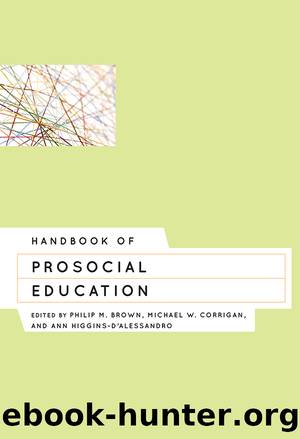Handbook of Prosocial Education by Brown Philip M.; Corrigan Michael W.; Higgins-D'Alessandro Ann

Author:Brown, Philip M.; Corrigan, Michael W.; Higgins-D'Alessandro, Ann [Brown, Philip M.]
Language: eng
Format: epub
Publisher: Rowman & Littlefield Publishers
Published: 2012-09-14T16:00:00+00:00
Case Study 12B
Implementing the Cultivating Awareness and Resilience in Education (CARE) Program1
Judith Nuss
1 The research reported here on the CARE program was supported by the Institute of Education Science, U.S. Department of Education, through grant #R305A090179 to Pennsylvania State University. The opinions expressed are those of the authors and do not represent views of the Institute or the U.S. Department of Education.
For more than five years, I led the implementation of social and emotional learning in the school district of Harrisburg, Pennsylvania. This was innovative, districtwide work. My experience as a teacher, school administrator, research assistant, community psychologist, and advocate for the improvement of teaching and learning, particularly in the urban setting, provided me with the knowledge and skills necessary for this challenging work. I am grateful to the people of Harrisburg and their educators for providing the motivation, support, and rewards necessary to overcome the inevitable barriers associated with the project described here.
CARE in a Small Urban Capital City School District
At the turn of the century and for two decades previously, Harrisburg School District was the worst of five hundred school districts in Pennsylvania by pre–No Child Left Behind (NCLB) measures. It was the only thing everyone in the area agreed about—how bad the schools were. You knew it by the revolving door of district superintendents who tried to do what they could and failed. You knew it when you could walk in any door of a school, but only after walking through groups of kids hanging around the doorways. You knew it when kids were everywhere in the hallways—all the time—running, shouting, fighting, cursing. You knew it by classroom doors, bolted or chain locked on the inside, and with broken windows that were boarded over or barred. You knew it by the void of books and informative bulletin boards and by the presence of graffiti everywhere. You knew it by the garbage on the floors and by classrooms that looked like someone’s old basement. You knew it by the few who would dare to enter a school bathroom. You also knew it by the faces of the adults in the building; the faces wore signs of depression, fear, anxiety, and lack of self-efficacy.
By 2010, some of these same faces had come and gone. Some of the others have changed into pleasant, self-confident faces eager to welcome enthusiastic students into safe, clean, and caring classrooms. A dynamic duo of experienced district-level superintendents, Dr. Gerald Kohn and Dr. Julie Botel, had come to town as change agents and started working the challenging and exhausting processes of positive change. School buildings were rehabilitated, expanded, and modernized. Teachers were provided high-quality professional development to implement balanced literacy, math, and science curricula. Teacher coaches were developed and provided support to teachers as they learned new habits of best practices. Teachers, unwilling or unable to improve their practices, were exited. Supports for learning were provided, including student referral systems, positive support interventions, school-based mental health services, and certified school counselors who counseled. Family nights
Download
This site does not store any files on its server. We only index and link to content provided by other sites. Please contact the content providers to delete copyright contents if any and email us, we'll remove relevant links or contents immediately.
Cecilia; Or, Memoirs of an Heiress — Volume 1 by Fanny Burney(32434)
Cecilia; Or, Memoirs of an Heiress — Volume 2 by Fanny Burney(31871)
Cecilia; Or, Memoirs of an Heiress — Volume 3 by Fanny Burney(31854)
The Lost Art of Listening by Michael P. Nichols(7406)
Asking the Right Questions: A Guide to Critical Thinking by M. Neil Browne & Stuart M. Keeley(5635)
We Need to Talk by Celeste Headlee(5542)
On Writing A Memoir of the Craft by Stephen King(4863)
Dialogue by Robert McKee(4321)
Pre-Suasion: A Revolutionary Way to Influence and Persuade by Robert Cialdini(4150)
I Have Something to Say: Mastering the Art of Public Speaking in an Age of Disconnection by John Bowe(3840)
Elements of Style 2017 by Richard De A'Morelli(3307)
The Book of Human Emotions by Tiffany Watt Smith(3238)
Fluent Forever: How to Learn Any Language Fast and Never Forget It by Gabriel Wyner(3028)
Name Book, The: Over 10,000 Names--Their Meanings, Origins, and Spiritual Significance by Astoria Dorothy(2939)
Good Humor, Bad Taste: A Sociology of the Joke by Kuipers Giselinde(2903)
Why I Write by George Orwell(2874)
The Art Of Deception by Kevin Mitnick(2736)
The Grammaring Guide to English Grammar with Exercises by Péter Simon(2710)
Ancient Worlds by Michael Scott(2625)
